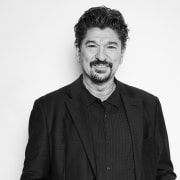This Time, Even the Jesus Shot Can’t Save J.B. Mauney

J.B. Mauney’s first flirtation with death at a bull riding happened when he was 18, stomped in Raleigh, N.C.
Assuming he had broken ribs, Mauney shunned the medic’s advice to get into the ambulance.
“At the hospital, they just tape you up and send you home anyways,” he said.
The next morning, the young bull rider said he felt this thing growing inside. His stomach was swollen hard as a rock. There was a knot big as a volleyball in his belly.
It was time to relent. At the hospital, doctors rushing Mauney into emergency surgery said that “thing” was his lacerated liver. He should have been dead before waking up.
Following the operation, Mauney was told he could ride again in eight months. Before that, if a horn hit him in the stomach, he wouldn’t survive.
Mauney took a job in a ball bearing plant, every day head-to-toe slathered in grease. He dreaded every minute. Four months in, he quit and headed for a bull riding.
At rider check in, he was asked, “Which doctor released you?”
“Dr. Mauney,” he replied.
That story (true, because with Mauney, they all are) is quintessential J.B. – the bravado, the lightning quick wit, the stubbornness, the questionable risk taking, and the unquenchable desire to ride bulls.
Of course, they let him ride. This was J.B. Mauney – John Wayne, Evel Knievel and Dale Earnhardt Sr. rolled up into one wiry, Jägermeister-swilling, Marlboro-smoking, take-no-prisoners, badass cowboy.
“Even when I was hurt bad, I was thinking How soon can I come back?” he said. “I know it doesn’t make sense to most people. In some ways, I think bull riding chose me rather than me choosing bull riding. I have to ride bulls. It’s who I am.”
Earlier this month, Mauney landed on his neck in a wreck at an Idaho rodeo. During corrective surgery, he had a disk removed, ending a Hall of Fame career highlighted with 538 premier series rides and two PBR World Championships (2013, 2015).
Consensus is Mauney, now 36, would have won more world titles had he played it safe, a word he’s not familiar with. He was known as “The Dragon Slayer,” always picking the rankest, meanest, most difficult bull, including Bushwacker, Sweet Pro’s Bruiser, Asteroid, and Air Time.
“There’s a difference between cocky and confident,” Mauney said in his North Carolina tobacco-field accent. “It’s a fine line, but there is a difference. I’ve never told anybody I was gonna ride any of those bulls. But I did tell them I expected to ride them because that’s my job. It’s what I do for a living, and I should ride every bull I get on. If you don’t believe you can ride every single one of them, there’s no point even coming out. Might as well stay home.”
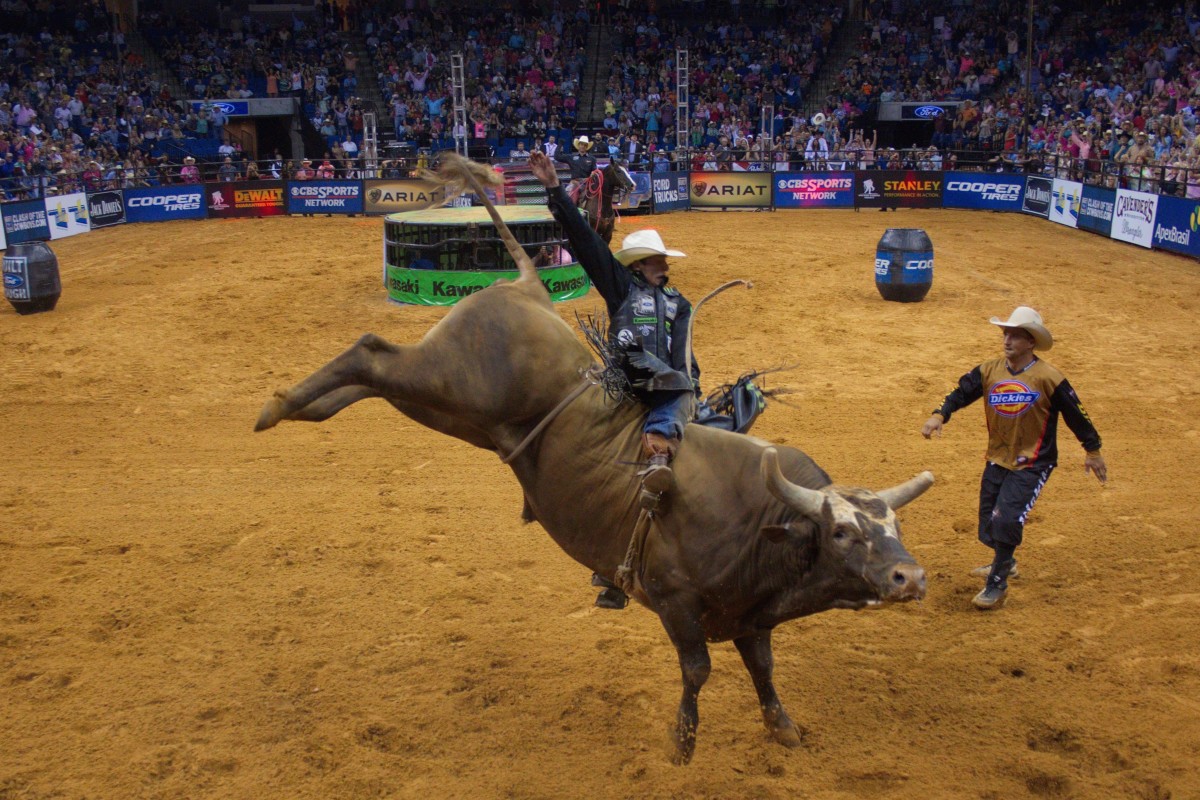
Since PBR was founded 30 years ago on the premise of pitting the world’s best bull riders against the most powerful and athletic bucking bulls on the planet, no bull rider was better at conquering the truly fearsome ones than Mauney. His turbulent trip aboard Bushwacker is the one that will be talked about as long as bull riding is a sport.
Mighty Bushwacker, a ripped chocolate brown bull, now retired, was a smart, ultra-competitive heavyweight. His owner Julio Moreno compares him to Muhammad Ali. He knew he was the greatest and strutted around the arena as such. Out of the arena, Bushwacker was not one of those bulls with a gentle disposition, allowing you to get up close and pet him. The surly bovine with a godly physique landing him on the cover of ESPN The Magazine’s “Body” issue was standoffish. A rider might call him buck-offish. He gave up one qualified ride, early in his career, then went on a dominant buck-off streak, 42 consecutive cowboys unceremoniously flung, thrashed, dumped, and ejected.
Even with crucial championship points on the line, Mauney kept picking mean ol’ Bushwacker. He refused to accept that any bull, no matter how great, could be unridden.
The loose-limbed, narrow-waisted, try-until-your-head-hits-the-ground cowboy may have had a plan – keep picking Bushwacker until lasting 8 seconds on him – but Bushwacker never had one.
There was no book on this bull. He’d blow from the gate like a Category 3 hurricane then change direction. Or not. Planning for the unpredictable was fool’s play.
Twice before, Mauney had stayed on Bushwacker for seven seconds, which was as useful as one second, because you had lost all the same. In bull riding, close doesn’t count. This ain’t horseshoes.
Once, Bushwacker yanked Mauney down and busted open his chin. Another time in Decatur, Texas, the joke was that Bushwacker, getting tired of the relentless rider, decided to kick the arena’s lights out and see if J.B. could solve him in the dark.
J.B. took his wrap and just as the gate opened, the building’s circuit breaker flipped.
“Whole place goes dark,” J.B. remembered. “I rode him about two jumps. I thought through my head, ‘I can’t ride this son of a gun in a lit up-ass arena, now I’m tied to him in the dark.’ He took another a big ol’ long jump. I tried to cheat him ‘cause I thought he was gonna go right, and all that did was engage the slingshot.”
Receiving the slingshot is harrowing on an ordinary bull. Mighty Bushwacker was to standard bulls what Secretariat was to horses. Nobody could see in the dark, but Mauney landed on his head 15 feet away.
Finally in Tulsa in August 2013, Mauney, coming back from a fractured fibula, would mount Bushwacker for the ninth time, which proved to be the charm. This time with the lights on J.B. rode Bushwacker as if body surfing a tornado, barely making the whistle before slammed into the dirt. Many say the ride, marked a whopping 95.25 points, is the greatest of all time. The video is featured in the new PBR Hall of Fame inside the spectacular National Cowboy & Western Heritage Museum in Oklahoma City.
Mauney, who said he felt “ten foot tall and bulletproof,” went on to stage the greatest come-from-behind surge in PBR history, winning five of the last 9 events of the 2013 season to make up 3,000 points in the standings over three months, surpassing Silvano Alves to win his first world title.
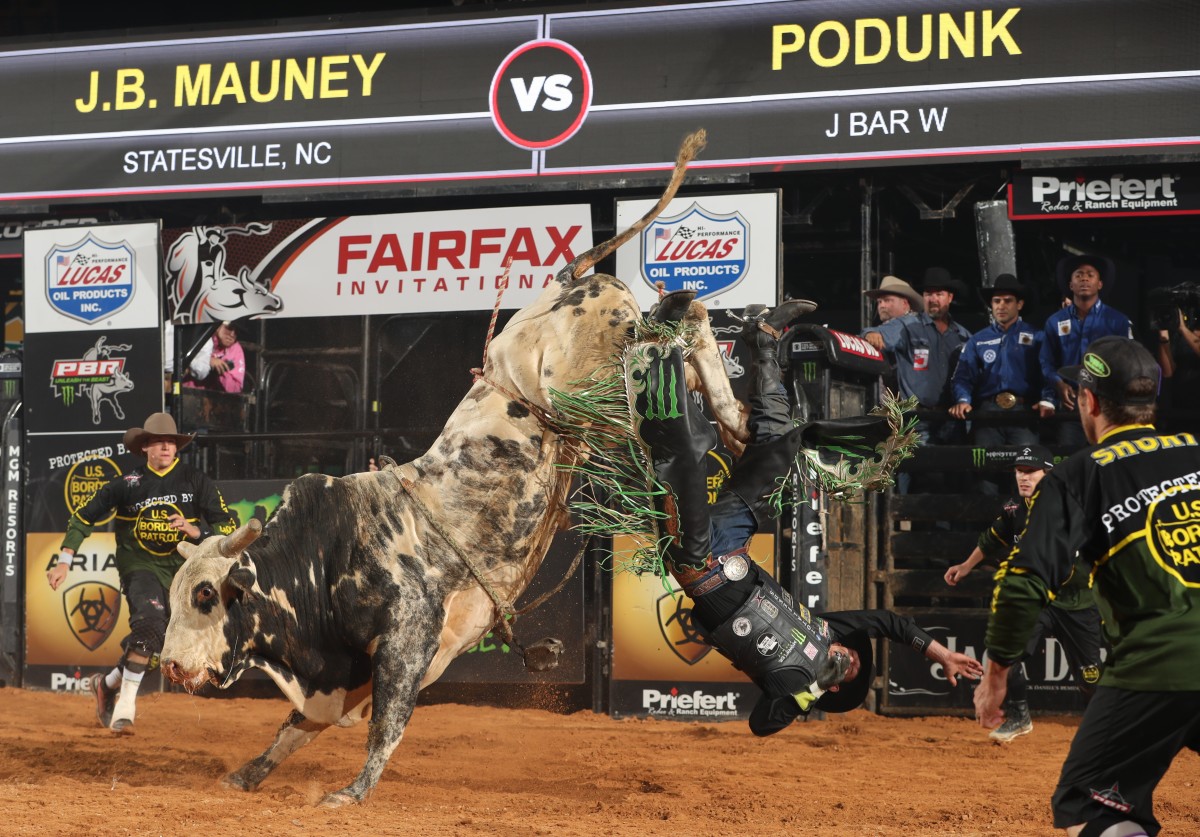
It was in Oklahoma City in an Uber this past April heading to the cowboy museum where I heard my latest favorite J.B. story.
The driver, a 50-something guy named Joseph, asks what’s going on at the museum. I’m headed to the Western Heritage Awards, I say, accepting an award for a book I wrote about bull riding. (Fat chance I’ll ever be able to say that again in my life, so why not?)
“Well now, you’re involved in bull riding!” Joseph exclaims. “Do you know a J.B. Mauney?”
“Ha! J.B wrote the Foreword to that book!” I am very proud to drop that name.
“I’ve got a J.B. Mauney story for you,” Joseph says.
Of course, I want it all, wiggling under the seat belt for a pen jammed into my COVID-tight Wranglers to take notes.
“Outside a doctor’s office, I pick up this skinny cowboy in a big ol’ cowboy hat and boots, head to toe in denim,” he says.
Of course, J.B. was coming from the doctor. If this were “Family Feud,” next to “HOSPITAL,” the top choice for Places an Uber Driver Picks Up J.B. Mauney would be “DOCTOR’S OFFICE.”
Joseph describes the skinny cowboy ambling over to the passenger side window and asking to sit in front.
To the obligatory “where are you from” question, J.B. says he’s from North Carolina. Joseph has no clue who he is. Asks why he’s in town.
“I came here for a shot,” J. B. says.
“All the way here? You can’t get the shot in North Carolina?”
“No sir, this is the only place to get this shot.”
“Well, what kind of shot would that be?”
“It’s The Jesus Shot.”
“The Jesus Shot? What in tarnation is that?”
“It’s a miracle,” J.B. says. “Makes you feel 20 years old again.”
First time in for The Jesus Shot, J.B. could barely stand. He says he strolled out of the doctor’s office feeling like he could walk on water.
“What do you do, putting you in a condition you can’t walk?” the driver asks.
“I ride bulls,” J.B. says.
“Oh, so you go to rodeos around North Carolina?”
“No, sir, all over the country. It’s been tougher lately. I’ve been hurt a lot. So, I come here.”
“Well, isn’t that something. A good living riding bulls?”
“Yes, sir,” Mauney says. “’Specially if you stay on and win.”
The curious driver has no idea he’s chauffeuring the most popular Western sports athlete who has made more than $7 million riding bulls. But his wife, though oblivious to The Jesus Shot, was a bull riding fan who religiously watched on TV.
At the airport, Joseph asks for and gets a photo with J.B., who never turns those requests down. Joseph sends his wife the photo, and not a minute later she calls, screaming into the phone, “IS THAT J.B. MAUNEY?”
Joseph hears about Bushwacker, the two world championships and most money ever made in the sport.
Dang, the Dragonslayer acted like he was nothing more than a sore, lunch-bucket journeyman.
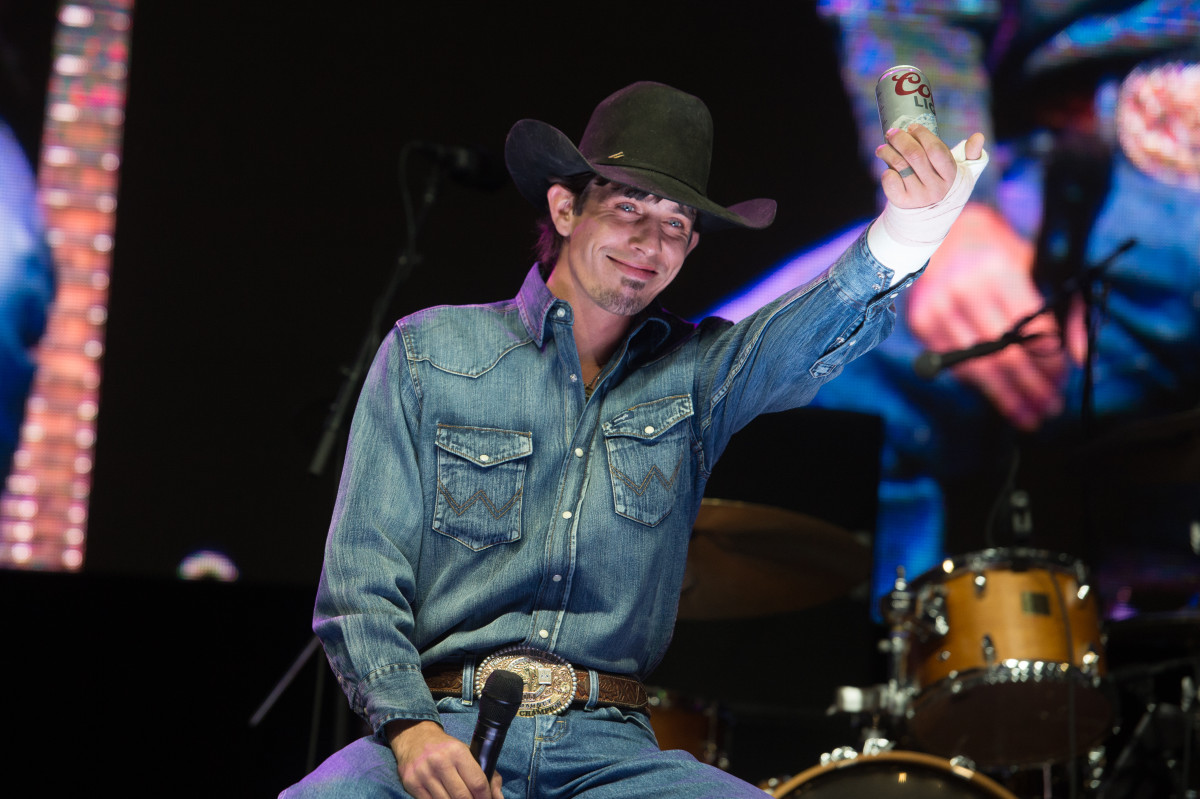
Mauney’s favorite times were when sponsor Bud Light would put four barrels of beer in the locker room, and for hours after the final bull bucked the cowboys would sit around and tell tall tales while enjoying the sponsor’s product.
The sport has grown, and that scene has changed.
Now with 79 million fans according to ESPN Sports Poll/Luker on Sports and launching an additional Team league that was announced on the front page of The Wall Street Journal, the lights are much brighter. In recent years, Mauney found a home in the more relaxed, off-the-radar atmosphere of professional rodeo, getting there from his ranch in Texas by running a wide-open 90 in the RV, little J.B. (Jagger Briggs) and his wife Samantha (a former barrel racer and daughter of five-time world champion rodeo cowboy Phil Lyne, not inaccurately described as a female version of Mauney, with even better bar-fight stories) sleeping in the back. Once there, he wouldn’t wind up on network television enjoying a cold one with a Marlboro red behind the bucking chutes.
Before the surveillance scrutiny of ever-present social media, the after-dark cowboy stories might have been wild, but Mauney, hip to his role as the face of the sport, always knew when to temper down. Whenever the opportunity presented itself, he reached into his heart to unveil the ten-foot-tall bulletproof hero idolized by kids, like when hearing about a young fan, Jace, who had recently lost his father to cancer. Jace’s dad, Boe Kellogg, was a bull rider, and Jace and his little brother Jett wanted to be just like their dad. Jace was just starting to get on steers when Boe passed.
Even though in the middle of the grueling five-round World Finals, gunning for his second world title, J.B. said he would meet 10-year-old Jace and 7-year-old Jett in Las Vegas. Hearing about the boys’ grief in losing their dad, he said, “Let’s not do this half ass.” On the dirt and off, Mauney’s philosophy is if you’re gonna be a bear, be a grizzly. He wanted to cook up something big and special for the reeling brothers.
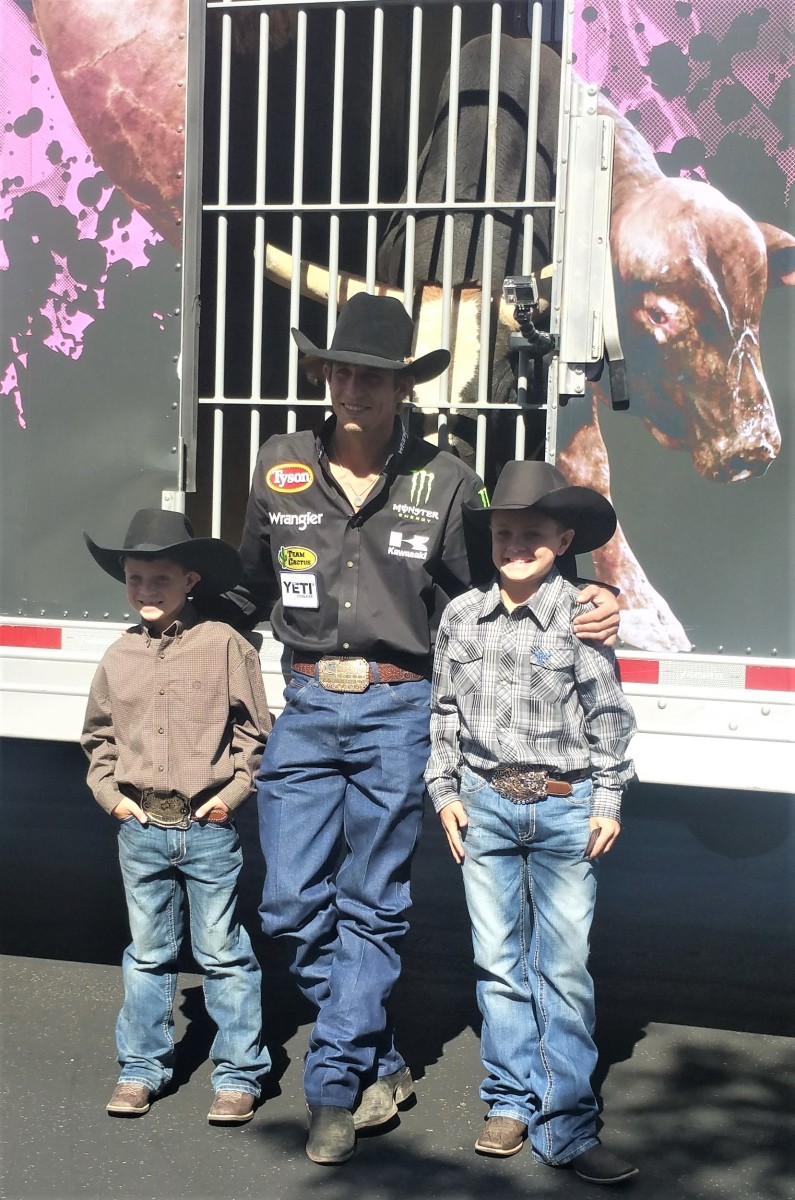
Working with the local Fox television station, a big surprise was arranged when a semi-truck hauling bulls rolled up to Jace and Jett’s house. The boys thought they was going to meet Radar, All Right All Right All Right, and the infamous Chicken on a Chain, when like a movie star on a set that had rolled up to them, a rail thin cowboy popped from a pickup truck behind the trailer, flashing a cocky smile and inviting Jace and Jett to walk the blue carpet with him at World Finals that night and then watch him try to win a million dollars and a gold buckle …which he did.
Today, Jace is 18, headed on a baseball scholarship to Webber International University, a D1 school in Central Florida. He’s said to be the toughest ball player on the field. As an established athlete, he still marvels at Mauney taking time during a world championship “to create what is still one of my greatest memories that will always be a light in what was the hardest time of my life.”
Jett, now 15, is a competitive high school sophomore playing football and golf. “I don't have a lot of early memories that don't involve the sadness of my dad’s illness or his passing, so this memory is one I will always cherish,” he said.
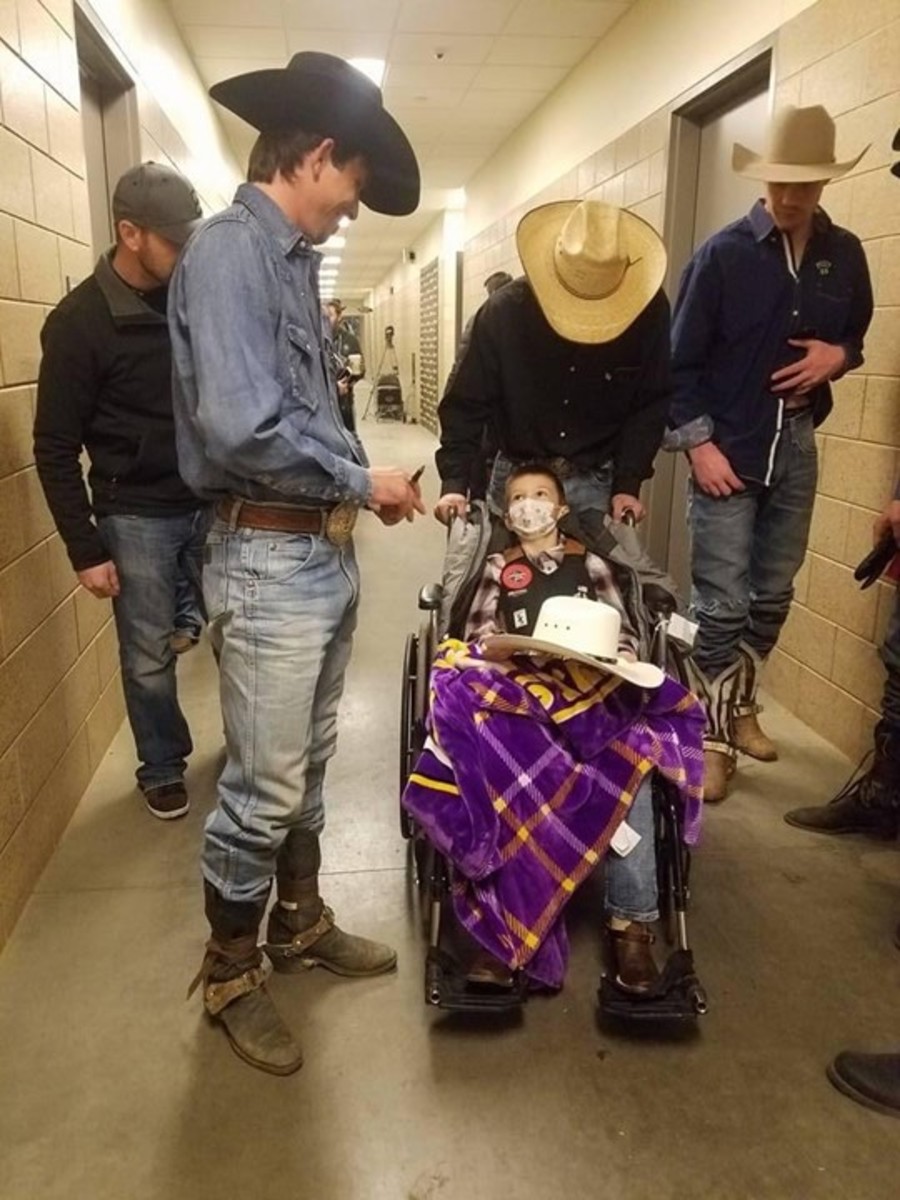
Another time, when the tour stopped in Sioux Falls, S.D., the same rep, Mandi McCary, found out that a very sick boy named Dyllen being treated at Sanford Children’s Hospital also idolized Mauney. Banged up again, Mauney was in Sports Medicine undergoing treatment and couldn’t leave the arena. But he said if the 9-year-old boy could get there, he’d spend time with him.
McCary pulled strings convincing doctors to issue a three-hour pass, and Dyllen was wheeled in, connected to an IV to hang out before Mauney rode Rocket Man to the tune of 87 points. Dyllen got better and has been coming to the annual PBR event in Sioux Falls ever since. Now 14, he’s tried his hand at bull riding and attended veteran rider Ryan Dirteater’s bull riding school in Minnesota. Still passionate about Western sports, the high school freshman is cancer-free and playing on his school’s football team.
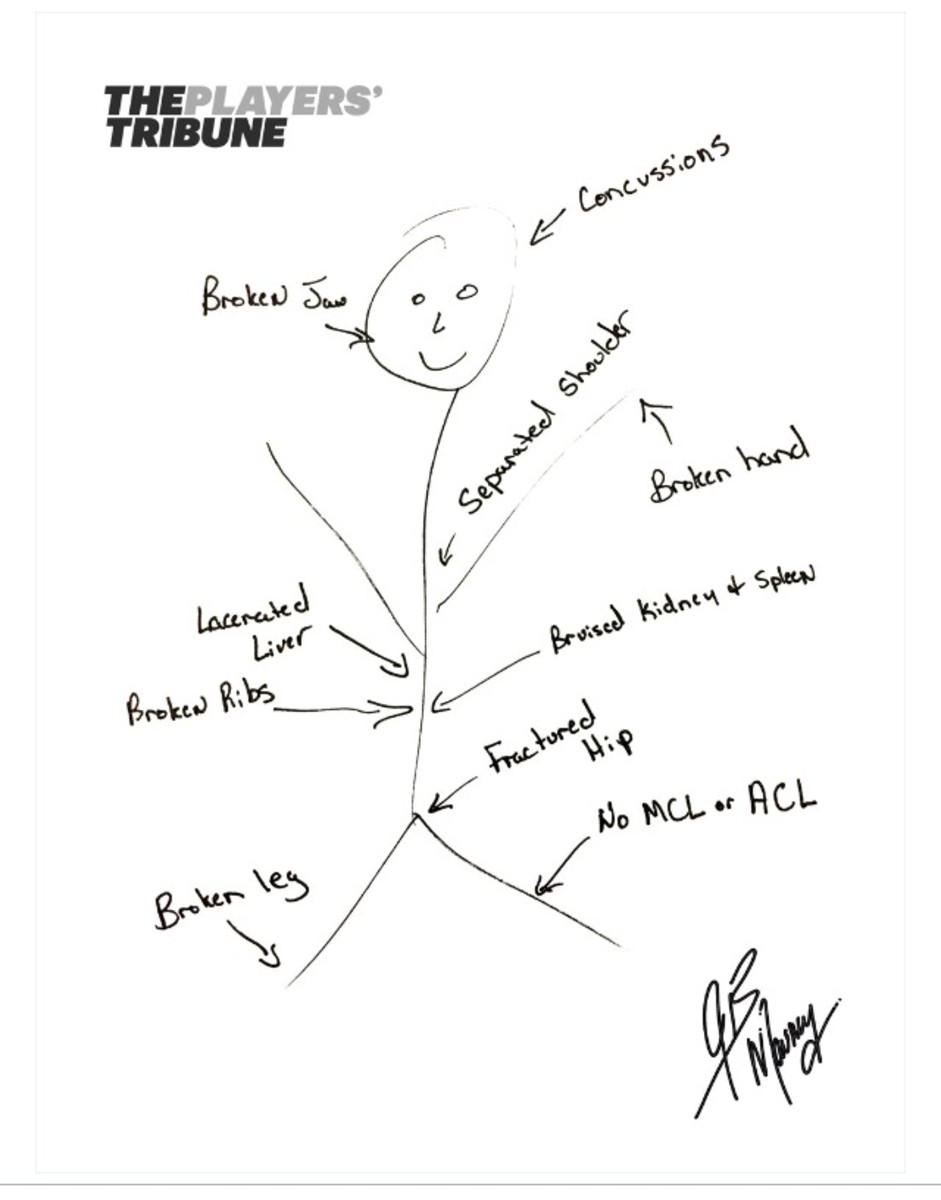
It’s impossible to have a conversation about the bull riding career of J.B. Mauney without discussing the physical punishment he’s endured. Was he born with a special gene? Or just raised differently? J.B. simply says he was taught by his father from an early age, “if you can’t deal with the pain, don’t play the game.”
All pro bull riders have to push through the hurt. Dr. Tandy Freeman, PBR’s Medical Director, an acclaimed orthopedic surgeon who has operated on Mauney’s shoulder twice, cites an unpublished pain tolerance study from the 1980’s in which athletes from different sports took a test, immersing their hands in a bucket of ice and timed for how long they could withstand it before pulling out. All the participating Western sports athletes kept their hand in the entire time, Freeman said. The only athletes with similar off-the-charts pain tolerance were hockey players and race car drivers.
“This sport is different than others,” Freeman said. “You can’t drive the lane in the NBA with a torn ACL, but you can ride a bull with that kind of injury. If these athletes can’t compete, they don’t eat. There’s a lot of pressure to ride. The cowboy-up mentality is, ‘do your job, and don’t whine about it.’ The guys who make it to this level have the talent and bare-down ability to deal with injuries.”
Mauney took that to the extreme as the poster boy for gritting through pain. Toward the end of his career, his shoulder would often separate during an out, triggering lightning bolts of pain. Freeman says that more than 99-percent of people on the planet would not be able to endure that degree of veritable torture then voluntarily keep doing what caused it.
“If you ever saw J.B. Mauney with his shirt off, the word ‘athlete’ wouldn’t spring to mind,” Freeman said. “But he had an innate ability to ride bulls, coupled with extraordinary effort, and absolutely no fear as far as I could tell. He refused under any circumstances to quit. He would drag around a bloody stump if he thought he could ride.”
What mere mortals viewed as “courage” may have been to Mauney’s detriment. Had he not competed so often when hurt, he might have had an even more successful career, Freeman said.
“But it wouldn’t have been as entertaining, and it wouldn’t have fit who he is. When J.B. was healthy, he could ride any bull, any time. When he was not healthy, he could still do that, but with a lot less predictability.”
If J.B. Mauney had quit smoking, ate vegetables, visited the gym, admired Jägermeister from afar, was tucked into bed before the clock struck midnight, picked easier bulls, recovered when hurt, had his knees and hip fixed, and won two or three more championships, you wouldn’t be reading this. Because no one would be marveling at the nearly mythological legend of J.B. Mauney.
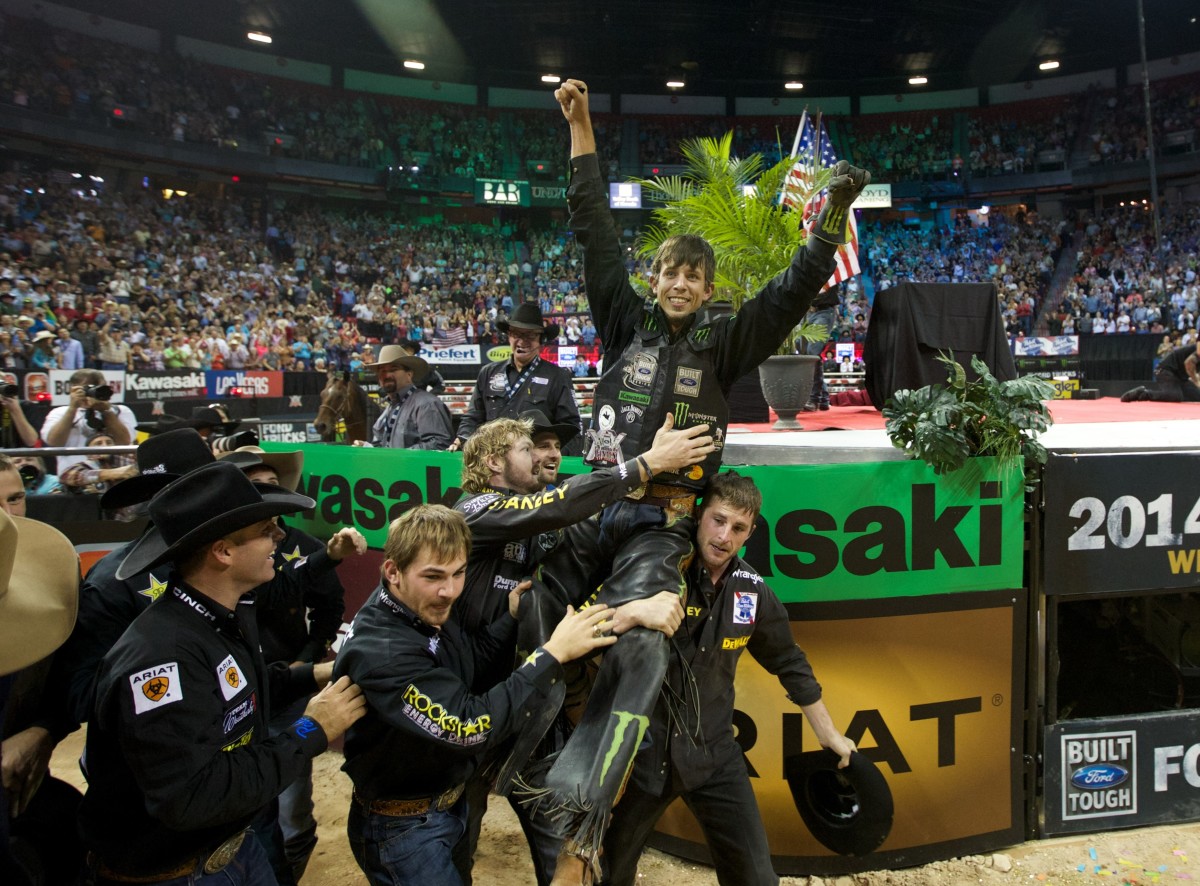
Few people in life live their dream and do what they want, completely on their terms.
Through bull riding, J.B. Mauney has lived that life.
“I never wanted anything else but to be a professional bull rider,” he wrote in the Foreword to Love & Try: Stories of Gratitude and Grit in Professional Bull Riding. “When I was a kid in North Carolina, I would think about bull riding 24 hours a day. My parents used to make me do my schoolwork, and only after I finished would they let me watch my boxes of bull riding tapes. That’s all I wanted to do. All I thought about. From the moment I opened my eyes to when I laid down at night.”
Like Dale Earnhardt Sr. in racing, J.B. Mauney in bull riding was a larger-than-life, polarizing figure. There was no middle ground. Fans loved him or hated him. And like his fellow sports icon from rural North Carolina, he was a hero to the common man – out of the arena between events seen working on the ranch rather than at leisure, on a horse or jamming in a fence post, hands dirty, never above his raisin’. Unlike Earnhardt, he has the opportunity to find a second act.
Mauney has raised bulls, so it’s unlikely he’ll leave the sport. Perhaps there’s a future as a Western sports broadcast commentator. Heck, he’s one of the best interviews in sports, often responding like a Marx Brother in cowboy boots. Case in point: a radio host on an aside about bull riders placing lucky mementos in their cowboy hat asked if Mauney places anything lucky in his hat. “Yeah,” he said. “My head.”
Bull riding is a fun, entertaining sport, and it’s one where some sacrifice everything. Reporters would inevitably wind around to asking about the ultimate costs of its inevitable brutality. J.B. once responded with his own question: “If something’s not worth dying for, what’s the point of even living?”
Not long after, fighting through yet another injury, that question was posed again. Mauney had won more than any other bull rider in history. He had two children. Wasn’t the risk too great? What would happen if he fell the wrong way and was crippled?
“’Guess if that happens,” he said, “I’ll just lay back in bed and think about all the good times I’ve had.”
Sports Illustrated's Rodeo Daily and the writer are making a donation to the Western Sports Foundation to help support injured bull riders.
